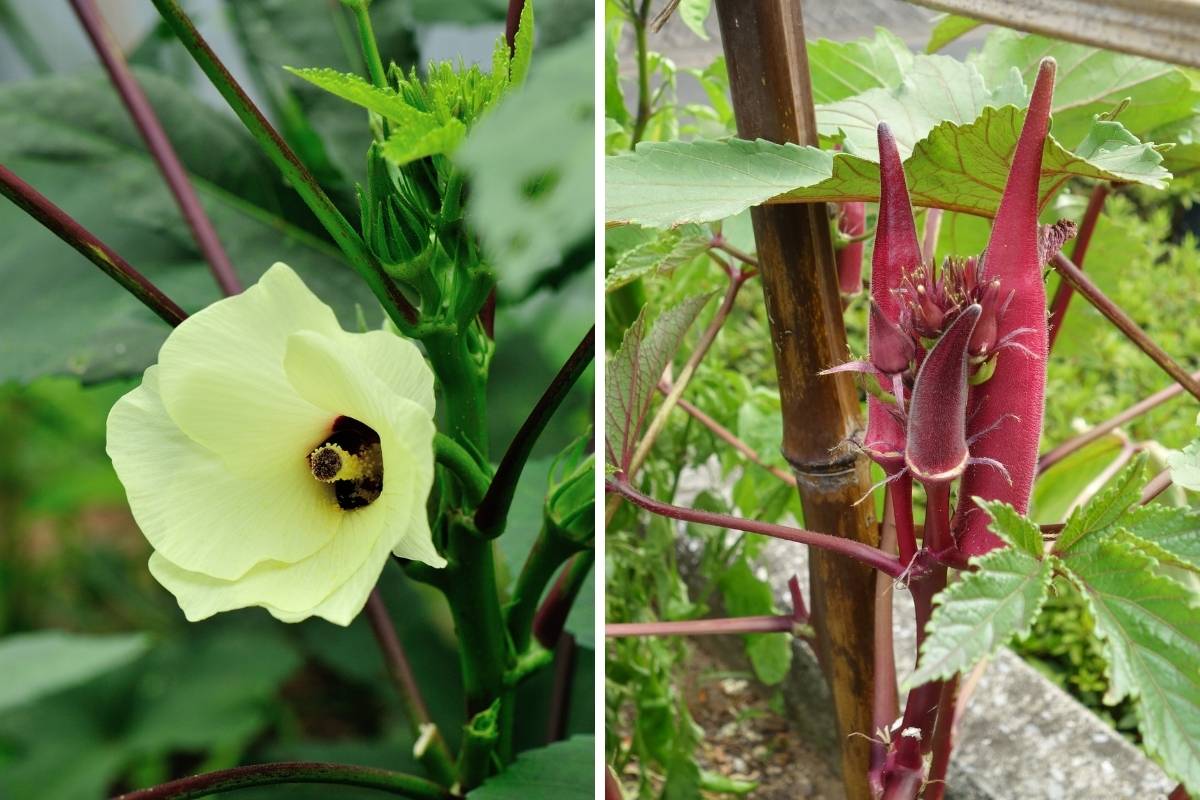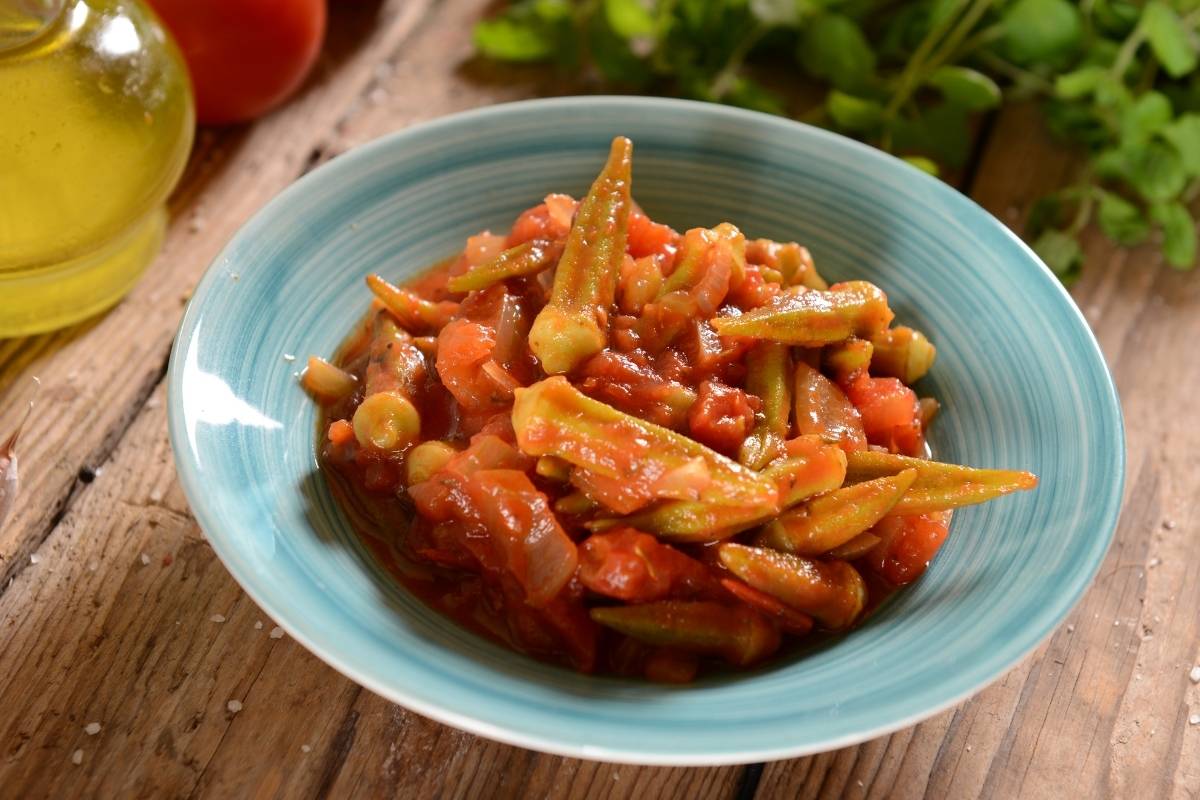Okra (Abelmoschus esculentus), also known as bhindi, ladies’ fingers or gumbo, is a feature in Caribbean, Creole, Cajun and Indian cuisines. So long as its need for warmth is taken into account, okra is easy to grow and highly productive, making it a valuable addition to home gardens.
A member of the mallow family and a relative of the hibiscus, okra is a frost tender perennial shrub that produces ridged, slightly hairy edible seed pods. Okra pods can be green or burgundy depending on the variety grown, although the burgundy ones turn green on cooking and the taste of both is identical.
Okra’s origins are disputed but it is thought to have originated in modern day Ethiopia, then spread to west Africa and Asia and later to the Americas. Its spread to the Americas was almost certainly due to the trans-Atlantic slave trade, and it quickly became a staple crop in America’s south where it’s gummy texture was put to use to thicken soups and stews.
Indeed, okra continues to be a staple in certain developing countries due to its need for hot weather and tolerance for drought, and as a good source of dietary fibre and vitamins C and K.
How to Grow Okra
Its need for hot weather means that much of Australia’s commercial okra crop is grown in the Northern Territory and Queensland, while Florida provides most of the US crop. However, it’s possible to grow plants in most areas of mainland Australia with proper care. Okra is naturally a perennial plant but it is frost tender and will not survive winter in cooler climates. Grow it as a perennial in tropical and subtropical zones, and as an annual in temperate climates.
A must is the provision of at least six and preferably eight hours of sunlight each day and a soil temperature of at least 20°C. Seed can be sown in drills outside 1cm deep if temperatures are warm enough, but otherwise it will need to be started off indoors or in the greenhouse. Some gardeners recommend soaking seeds overnight prior to sowing as this can reduce germination time and improve the success rate.
Space seedlings 60cm apart and plant in a sheltered position. Okra plants can grow up to around 2 metres tall so may need some staking.
With regard to soil, okra requires a free-draining, slightly alkaline soil. It will tolerate relatively poor soils, but will thrive much better in a moderately fertile loam. Add some well-rotted manure or compost prior to planting and then add more compost, well-rotted manure or organic fertiliser around six weeks after germination to cater to the plant’s rapid growth.
Okra is regarded as a drought tolerant crop, but will still need consistent watering after sowing seeds and while the plants are young. Okra can also be grown in large 15 to 20 litre pots and will then need to be watered more regularly.
Pests and Diseases
Diseases that can ail okra include verticillium wilt and powdery mildew, while pests include caterpillars, aphids and whitefly. Verticillium wilt, a fungal disease which causes yellowing and shrivelling of lower leaves and wilting in hot weather, is a particularly bad disease as it is soil-borne. This means okra or other susceptible crops cannot be grown in that patch of soil for several years after an outbreak.
The affected plants should not be added to the compost heap at the end of the growing season as this could spread the disease to other parts of the garden. Individual plants may recover enough to give a crop in that year, especially if given adequate nutrition and water.
How to Harvest Okra
Okra is a quick-growing plant in the right conditions and will usually start to produce pods around 12 to 14 weeks after sowing. Pods will then grow quickly and can soon swell to an inedible size. Frequent picking is therefore essential. The pods should be picked when they are young and finger length (around 8cm) as they will be less woody at this stage and have less of the mucilaginous goo for which they are renowned.
The pods do not store well and are best eaten fresh, although they can last for a couple of days in a paper bag in the fridge. They also bruise quite easily, so take care when picking.
The leaves of okra plants are also edible when young and can be eaten fresh in salads or cooked in a similar manner to the greens of beets and dandelions.
The seeds of okra were used as a substitute for coffee during the American Civil War when importation of the coffee bean was disrupted. If you wish to create your own caffeine-free coffee alternative, allow the pods to mature on the plant until they turn brown. They can then be roasted and ground. Be aware that allowing pods to mature and set seed is likely to reduce pod production in the medium and long-term for that season’s harvest, so is best done at the end of the season.
How to Eat Okra
Okra has a slightly grassy flavour that’s been compared to that of green beans, asparagus or eggplant. This mild flavour is generally paired with other bolder ingredients. Its okra’s texture, though, that makes it a unique vegetable in the kitchen. Variously described as slimy, gummy and viscous, okra contains mucilage, a naturally occurring gelatinous solution also found in chia and cassava.
Okra can be used in a variety of dishes: stewed okra is popular in parts of the Caribbean, while it is sometimes used as a thickener for gumbo in the southern US. Asian cuisine often pairs it with chicken and uses it in spicy vegetable dishes. Other possibilities include stewing it with tomatoes or frying it with a crisp batter to contrast with it’s soft texture.
Okra is not usually eaten raw due to its slimy texture. Its sliminess can be reduced by cutting it up and soaking it in vinegar or lemon juice prior to cooking or by chargrilling over a hotplate. For many cooks, though, the best approach is to celebrate, rather than attempt to hide, okra’s unique gumminess.
Given it's versatility in the kitchen and its productivity in the garden, okra may be worth adding to your list of unusual vegetables to grow.









